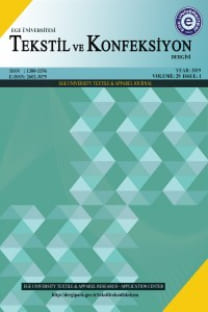The effects of sewing thread properties on the needle thread tension in an industrial sewing machine
Dikiş makinesinde dikiş iplik özelliklerinin iğne ipliği gerilimine etkileri
___
- 1.Ferreira F.B.N., Harlock S.C. and Grosberg P., 1994, Thread Tensions on Lockstitch Sewing Machine (Part I), International Journal of Clothing Science and Technology, Vol. 6, No 1, pp:14-19.
- 2.Harrison P.W.,2000, Sewing Threads,The Textile Institute, Textile Progress, Vol. 30, No 3/4, pp:59-61.
- 3.Nayak R.,Padhye R.,Dhamija S and Kumar V.,2013, Sewability of Air-jet Textured Sewing Threads in Denim, Journal of Textile and Apparel Technology and Management, Vol.8(1), pp:1-11.
- 4.Baytar F.,2002, Analysis of Needle Penetration Forces In Lockstitch Sewing Process, MSc Thesis, İTÜ.
- 5.Laing R.M., Webster J.,1998, Stitches and Seams, The Textile Institute, pp: 17.
- 6.Midha V.K., Mukhopadhyay A., Chatopadhyay R. and Kothari V.K., 2009, Studies on the Changes in Tensile Properties of Sewing Thread at Different Sewing Stages, Textile Research Journal, Vol. 79(13), pp: 1155-1167.
- 7.Bamberg M., Circular Knitting, 1995; pp: 220221.
- 8.Gurarda A., Yukseltan E., Kaplangiray B. and Kanık M., 2013, The Effects of Lubricants on the Frictional Properties of Sewing Threads, Textile Research Journal, DOI: 10.1177/0040517512470199.
- 9.Gurarda A, Kaplangiray B, Kanık M, Yukseltan E., 2011, The Effects of Lubricants on the Stiffness of Sewing Threads, Tekstil ve Konfeksiyon, Vol.21(3),pp: 272-279.
- 10. http://www.graf-chemie.com/lang-en/produkte/technik/textil/84-graf-lubrication system.html.
- ISSN: 1300-3356
- Yayın Aralığı: 4
- Yayıncı: Ege Üniversitesi Tekstil ve Konfeksiyon Araştırma & Uygulama Merkezi
Mathematical analysis of warp elongation in weaving machines with positive backrest system
Esra Zeynep YILDIZ, Turan ATILGAN
Duygu EROĞLU YILMAZ, H. Cenk ÖZMUTLU, Seyit Ali KÖKSAL
The effects of sewing thread properties on the needle thread tension in an industrial sewing machine
Mehmet KANIK, Ayça GÜRARDA, Binnaz KAPLANGİRAY, Pınar KONCER
Investigation of effect of special washing processes on denim fabrics' properties
Selime MENTE ÇOLAK, Urana DANDAR, Eylem KILIÇ
Designing of conductive yarn knitted thermal comfortable shirt using battery operated heating system
Gilbert De MEY, Mert ÖZÇELİK, Anne SCHWARZ, KAZANI Ilda, Carla HERTLEER, Lieva LANGENHOVE VAN, Nevin Çiğdem GÜRSOY
NAR (Punica granatum) KABUĞUNUN YÜN KUMAŞI DOĞAL BOYAMA ÖZELLİĞİ
Mustafa TUTAK, Gülcan ACAR, Onur AKMAN
